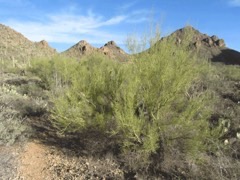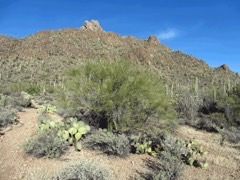 |
|
wikimedia.org Homer Edward Price |
 |
| wikimedia.org Homer Edward Price |
Translate this page:
Summary
Yellow or foothill paloverde (Parkinsonia microphylla) produces edible young pods and mature seeds, both requiring thorough cooking. Young pods are less fleshy and sharper than those of blue paloverde, while the beans are mild but slimy after boiling. Traditional use by Native Americans suggests some food value, though large amounts may be unsafe due to mild toxins. USDA Zones 8–11; native, not invasive. This name is a synonym of Parkinsonia microphylla.
Parkinsonia microphylla is a spiny, deciduous shrub or a small tree usually growing to 4m. The plant is harvested from the wild for local use as a source of food, and has potential for use as a protein supplement. It is sometimes grown as an ornamental in semi-arid regions[1050].
Physical Characteristics

 Cercidium microphyllum is a deciduous Tree growing to 4 m (13ft) by 6 m (19ft) at a slow rate.
Cercidium microphyllum is a deciduous Tree growing to 4 m (13ft) by 6 m (19ft) at a slow rate.
See above for USDA hardiness. It is hardy to UK zone 9.
Suitable for: light (sandy), medium (loamy) and heavy (clay) soils, prefers well-drained soil and can grow in nutritionally poor soil. Suitable pH: mildly acid, neutral and basic (mildly alkaline) soils. It cannot grow in the shade. It prefers dry or moist soil and can tolerate drought.
UK Hardiness Map
US Hardiness Map
Synonyms
C. microphylla (Torr.) Britton & Rose; Parkinsonia microphyllum Torr.
Plant Habitats
Edible Uses
Edible Parts: Flowers Seed Seedpod
Edible Uses:
Edible Portion: Seeds, Pods, Flowers. Seeds - cooked[257 , 1333 ]. The dried beans were roasted (often until almost burnt) then ground into a powder and made into a mush or into cakes[257 ]. Usually viewed as a famine food and only used when better foods were not available[257 ]. The seeds are rich in protein (they contain around 22% protein, 50% carbohydrate and 18% fat) and have potential for use as a human food[1543 ]. The dried, powdered seed has a digestibility rating of 76%, increasing to 85% when cooked - this is higher than for many of the commonly eaten legume foods. The seeds do contain antinutritional factors, including trypsin inhibitors, phenols, alkaloids and haemagglutinin, but these are not present in high enough concentration to constitute a major nutritional problem. These antinutritional factors are soluble in saline solutions and can be removed by soaking or during cooking[1543 ]. The seedpods are 35 - 110mm long and 7 - 9mm wide, containing 1 - 4, brown, sub-globose seeds 8 - 10mm long and 5 - 7mm wide[1333 ]. Carbon Farming Solutions - Staple Crop: protein (The term staple crop typically refers to a food that is eaten routinely and accounts for a dominant part of people's diets in a particular region of the world) [1-1]. Yellow paloverde (Cercidium microphyllum or Parkinsonia microphylla), also known as foothill or littleleaf paloverde, is a dominant tree of the southwestern deserts. Like other paloverde species, its seeds and pods should be treated with caution, as they may cause digestive problems and are considered mildly poisonous if not properly prepared. Despite these concerns, Native Americans traditionally ate both immature pods and mature seeds after cooking. The young pods, available in late spring through summer, are moist, green, and fibrous, though less fleshy than those of the blue paloverde. Their constricted form around the seeds reduces the amount of edible material, and the tips may be sharp. The flavor is similar to peas, though it carries earthy and somewhat unappealing accents. Cooking improves taste but does not completely eliminate stringiness. Later in the season, mature beans become available. These are hard and encased in papery pods, which crumble easily after drying. When properly soaked and boiled, the beans soften and resemble ordinary white beans in flavor, though they may develop a slimy texture. Changing the cooking water helps reduce this mucilage. As with other paloverdes, insect damage is common, so careful sorting is needed.
Although abundant and easy to gather, the pods and beans of yellow paloverde are not high-quality foods and were generally used by Native Americans only when other resources were limited [2-3].
References More on Edible Uses
Medicinal Uses
Plants For A Future can not take any responsibility for any adverse effects from the use of plants. Always seek advice from a professional before using a plant medicinally.
None Known
References More on Medicinal Uses
The Bookshop: Edible Plant Books
Our Latest books on Perennial Plants For Food Forests and Permaculture Gardens in paperback or digital formats.

Edible Tropical Plants
Food Forest Plants for Hotter Conditions: 250+ Plants For Tropical Food Forests & Permaculture Gardens.
More

Edible Temperate Plants
Plants for Your Food Forest: 500 Plants for Temperate Food Forests & Permaculture Gardens.
More

More Books
PFAF have eight books available in paperback and digital formats. Browse the shop for more information.
Shop Now
Other Uses
The wood is hard and heavy[1050]. Landscape Use: Xeric and/or native desert gardens as a small multi-branched tree or large background shrub. The Seri people, a Native American group of northwestern Mexico, call this tree ziipxöl; They strung the seeds for necklaces.
Special Uses
Carbon Farming
References More on Other Uses
Cultivation details
Management: Standard Staple Crop: Protein Wild Staple Crop
Climate: subtropical. Humidity: arid to semi-arid. Parkinsonia microphylla is a plant of arid and semi-arid climates in southwestern N. America, experiencing high summer temperatures and a highly variable rainfall[1050 ]. Requires a well-drained soil in a sunny position[1050 ]. The leaves of this species are ephemeral. The plant usually comes into leaf in the rainy season, but the leaves are soon deciduous, the function of photosynthesis being carried out by the green stems[1333 ]. The plant often responds poorly to coppicing[1050 ]. This species occasionally forms hybrids throughout its range with blue paloverde (Parkinsonia florida). In Mexico, it hybridizes with Parkinsonia praecox to form the natural hybrid Sonoran paloverde (Parkinsonia x sonorae)[1050 ]. Although many species within the family Fabaceae have a symbiotic relationship with soil bacteria, this species is said to be devoid of such a relationship and therefore does not fix atmospheric nitrogen[1309 ]. It is slow growing. Trees can live for several hundred years. Carbon Farming Solutions - Cultivation: wild staple. Management: standard (Describes the non-destructive management systems that are used in cultivation) [1-1].
Carbon Farming
-
Management: Standard
Plants grow to their standard height. Harvest fruit, seeds, or other products. Non-Destructive management systems.
-
Staple Crop: Protein
(16+ percent protein, 0-15 percent oil). Annuals include beans, chickpeas, lentils, cowpeas, and pigeon peas. Perennials include perennial beans, nuts, leaf protein concentrates, and edible milks.
-
Wild Staple Crop
Some wild plants have strong historical or contemporary use. Although they are not cultivated crops, they may be wild-managed.
References Carbon Farming Information and Carbon Sequestration Information
Temperature Converter
Type a value in the Celsius field to convert the value to Fahrenheit:
Fahrenheit:
The PFAF Bookshop
Plants For A Future have a number of books available in paperback and digital form. Book titles include Edible Plants, Edible Perennials, Edible Trees,Edible Shrubs, Woodland Gardening, and Temperate Food Forest Plants. Our new book is Food Forest Plants For Hotter Conditions (Tropical and Sub-Tropical).
Shop Now
Plant Propagation
Seed, acid scarification of seeds in 95% sulfuric acid for 30 min to 1 hr followed by a 15 minute rinse in cool to tepid water. Sow immediately thereafter.
Other Names
If available other names are mentioned here
Yellow paloverde, Yellow Palo Verde, Ziipxol.
Native Range
NORTHERN AMERICA: United States (Arizona (south), California (southeast)), Mexico (Baja California (Norte), Baja California Sur, Sonora)
Weed Potential
Right plant wrong place. We are currently updating this section.
Please note that a plant may be invasive in one area but may not in your area so it's worth checking.
Native to the southwestern U.S. deserts; not generally considered invasive within its natural range.
Conservation Status
IUCN Red List of Threatened Plants Status : This taxon has not yet been assessed

Growth: S = slow M = medium F = fast. Soil: L = light (sandy) M = medium H = heavy (clay). pH: A = acid N = neutral B = basic (alkaline). Shade: F = full shade S = semi-shade N = no shade. Moisture: D = dry M = Moist We = wet Wa = water.
Now available:
Food Forest Plants for Mediterranean Conditions
350+ Perennial Plants For Mediterranean and Drier Food Forests and Permaculture Gardens.
[Paperback and eBook]
This is the third in Plants For A Future's series of plant guides for food forests tailored to
specific climate zones. Following volumes on temperate and tropical ecosystems, this book focuses
on species suited to Mediterranean conditions—regions with hot, dry summers and cool, wet winters,
often facing the added challenge of climate change.
Read More
Expert comment
Author
(Torr.) Rose & I. M. Johnst
Botanical References
Links / References
For a list of references used on this page please go here
A special thanks to Ken Fern for some of the information used on this page.
Readers comment
| Add a comment |
|
If you have important information about this plant that may help other users please add a comment or link below. Only comments or links that are felt to be directly relevant to a plant will be included. If you think a comment/link or information contained on this page is inaccurate or misleading we would welcome your feedback at [email protected]. If you have questions about a plant please use the Forum on this website as we do not have the resources to answer questions ourselves.
* Please note: the comments by website users are not necessarily those held by PFAF and may give misleading or inaccurate information.
To leave a comment please Register or login here All comments need to be approved so will not appear immediately.
|
Subject : Cercidium microphyllum
|
|
|
|